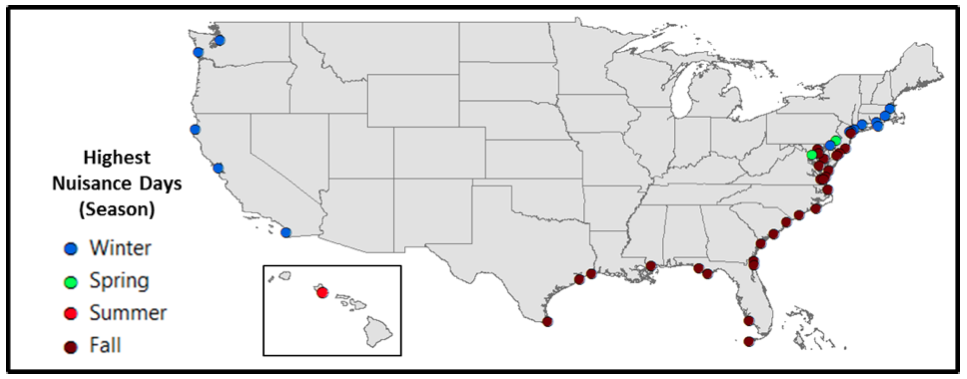Global warming is easily linked in our minds to calamities, and it can be easy to grasp how rising seas contribute to catastrophic floods. Storm surges caused by hurricanes, such as those that wiped out parts of New Orleans in 2005 and inundated New York two years ago, serve as soggy tocsins. They act as clear reminders of the need to build and plant better defenses.
“Not only are extreme flooding events reaching higher grounds and covering larger areas due to SLR [sea-level rise], the frequency and duration of these extreme flood events are increasing,” the National Oceanic and Atmospheric Administration wrote in a recent report.
But not every sodden manifestation of sea-level rise is disastrous.
Eight of the 10 studied cities that have seen the greatest increases in nuisance flooding rates are on the East Coast, where rising seas are often combined with subsiding land levels.
During recent decades, the rate of nuisance floods in coastal regions has been rising around the United States. It’s a damaging trend that could easily be overlooked if not for a trove of data that confirms its slow creep.
“Another consequence of SLR is the increase in lesser extremes such as occasional minor coastal flooding experienced during high tide,” the NOAA report notes. Such nuisance floods aren’t deadly—but they sever streets, overwhelm sewers and storm-water drains, and deteriorate infrastructure that wasn’t designed to withstand salty inundations. “These events are becoming more noticeable and widespread along many U.S. coastal regions and are today becoming more of a nuisance.”
NOAA analyzed data from an array of 210 water gauges to track changes in the frequencies of nuisance floods. It concluded that the rate had risen on all three coasts since 1960—in some cases spectacularly so.
Nuisance floods tend to strike different coastlines during different seasons. On the West Coast and in the Northeast, they’re a winter phenomenon. Further south on the East Coast and along the Gulf Coast, floodwaters tend to rise as autumnal leaves fall.

(Map: NOAA)
Eight of the 10 studied cities that have seen the greatest increases in nuisance flooding rates are on the East Coast, where rising seas are often combined with subsiding land levels. The biggest increases were in parts of Maryland, where nuisance floods now strike Annapolis and Baltimore nearly 10 times more often than was the case 50 years ago.
The biggest increases in nuisance flooding along the Gulf Coast were found in Port Isabel, Texas, where rates have increased five times. On the West Coast, San Francisco, California, has seen nuisance flood rates more than triple.
In 1950, nuisance flooding generally returned to prone areas once every one to five years. By 2012, the return periods of nuisance floods had shrunk considerably—typically less than three months (0.25 years), as shown in the following chart:

(Map: NOAA)
The agency says it published the report to “heighten awareness of a growing problem”—and to encourage governments to take steps to protect neighborhoods from a veiled quandary that seems to be playing out in slow motion.





